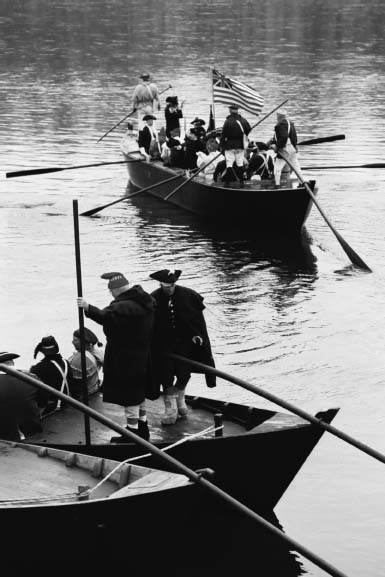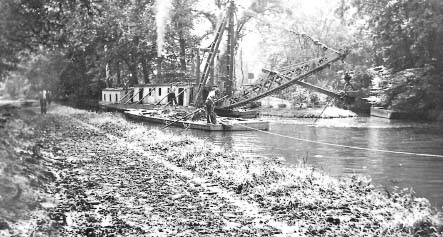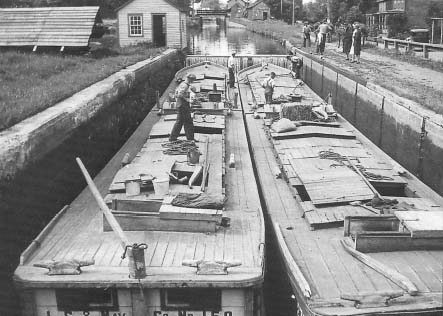The Delaware Canal (11 page)
Read The Delaware Canal Online
Authors: Marie Murphy Duess

Chapter 6
Snappers and Stiff Boats
Early Travel on the Delaware
Aside from the canoes of the Native Americans who were the first inhabitants living along its shores, the first boats on record that traveled on the graceful 360-mile river that separates Pennsylvania from New Jersey and parts of New York were captained by Europeans. European exploration in the region began with Henry Hudson in 1609, followed by Adrian Block of the Netherlands and, in 1610, English Captain Samuel Argall, who named the watercourse after Lord De La Warr, governor of Virginia.
In his search for the Northwest Passage in the Americas, independent explorer Captain Thomas Yong of England sailed up the Delaware River as far as the falls, near what is now called Morrisville. Captain Yong spent time exploring the fertile river valley and making friends with the Lenni-Lenape, who were the first inhabitants in the region. His Native American friends told him of great mountains beyond the fallsâthe same mountains that would provide anthracite coal and feed the Industrial Revolution 150 years laterâand in a report to King Charles, he promised to find a way to move beyond the falls and explore farther up the river. His promise was never to be kept because he left the Delaware Valley to continue exploration on the Hudson River and did not return.
When William Penn first arrived in America and staked out the land that was granted to him by King Charles II, his mode of transportation from Philadelphia was by boat. He was greatly impressed with the area he called “Buckinghamshire,” where his country home, Pennsbury Manor, was built. It took five hours for visitors to Pennsbury Manor to travel back and forth from Philadelphia by river, and the unpredictable currents could make it a difficult trip. Yet, because of the lack of decent roadways, the Delaware was the easiest way to travel locally.
The time it took to travel on the Delaware by a boat similar to William Penn's depended upon the wind and the strength of the men who were onboard to row when there was no breeze. Homesteadsâalso called plantationsâalong the Delaware in colonial days provided stone docks along the river so that boats could stop to discharge passengers in safety.
Ferries were established to provide crossings between New Jersey and Pennsylvania. Colonists wanted accessible water supplies for their settlements, and many of the sales from William Penn's earliest records show that immigrants purchased tracts of land along the rivers, streams and feeder creeks first. Later purchasers chose tracts between streams. Major waterways were used to transport produce and manufactured goods to Philadelphia and New Jersey, and so boats, canoes and barges were found cluttered along the shores of the Delaware. A Pennsylvania law was enacted in March 1771 that declared:
When the improvement of the navigation of rivers is of great benefit to commerce, and whereas many persons have subscribed large sums of money for this purposeâ¦the Delaware and Lehigh Rivers shall be common highways for the purpose of Navigation
.
45
Eventually, sawmills sprouted up in the dense hardwood forests of the countryside, and the trees were cut along the Delaware and floated down to the city, at first individually and then tied together to make rafts.
The first raft consisted of six pine trees, or logs, 70 feet long and to be used for masts for ships then building at Philadelphia. A hole was cut through the end of each log and the logs strung on a pole, called a “spindle,” with a pin through each end of the pole outside the logs, to prevent them spreading apart
.
46
The travel of log rafts through the numerous falls and rifts was extremely dangerous. Raftsmen took their lives in their hands every time they embarked down the river anywhere north of Philadelphia. Dangers along the Delaware included Foul Rift above Easton, an obstacle course of falls a mile below New Hope called Wells Falls, the Scudder's Falls and a nine-foot fall over a length of thirty-five hundred feet at Trenton Falls, all of which were major impediments in navigating the river.
According to W.W. Davis's
History of Bucks County
, two men, Mr. Skinner and Mr. Parks, successfully navigated the first raft to Philadelphia over the falls, and upon arriving in Philadelphia unscathed, Skinner and Parks were heralded as heroes. Mr. Skinner, who was the “captain” of the raft, was called “Lord-High-Admiral of the Delaware” until his death.
47
The height of river rafting was between 1835 and 1850. In 1873, there were reportedly thirty-eight mills at twenty-three locations between Easton and Morrisville.

Durham boats were first used to transport cargo on the Delaware River before the canal was built. General George Washington used these boats to cross the Delaware on that infamous Christmas night before the Battle of Trenton.
Courtesy of the Washington Crossing Historic Park, administered by the Pennsylvania Historical and Museum Commission
.

Work boats, like this shovel dredge, kept the canal waters at a safe depth. Maintenance on the canal was ongoing throughout the season.
Courtesy of the Pennsylvania Canal Society Collection, National Canal Museum, Easton, PA
.
In the 1700s, Robert Durham designed a boat that was sturdy enough to carry iron made at the Durham Furnace to the markets in Philadelphia and beyond. These flat-bottomed boats were built with sides that were twelve to fourteen feet from the boats' ends, which tapered in to glide easily through the water. They measured approximately sixty feet long by eight feet wide and forty-two inches deep and could carry a load of seventeen tons while traveling downstream and two tons when moving upstream. In time, they were employed to carry not only pig iron and ore from the Durham Furnace and Mills, but also grain, whiskey, flour, corn and other products to and from the region. The Durham boat required a crew of at least three men to operate it, and they used twelve- to eighteen-foot “setting poles” to steer the boat going downstream and to push the boats upriver. Later models were fitted to use oars. These boats played a major role in one of the most important battles of the Revolutionary War. They were the method of transportation used by General George Washington to deliver his troops across the Delaware on Christmas night in 1776 before winning the Battle of Trenton. There are several Durham boats at Washington Crossing Historic Park on display, and they are still used in the annual reenactment of that infamous crossing every Christmas.
Arks were also built to transport goodsâprimarily anthracite coalâon the Delaware. Built in Mauch Chunk in 1806 by a man named William Turnbull, the first ark was loaded with three hundred bushels of coal and successfully floated down to Philadelphia, where the ark was then broken up and sold for lumber. Subsequent arks were rectangular boxes 20 to 25 feet long and 16 feet wide connected by hinges so that a chain of arks, as long as 180 feet, could be assembled quickly. But transportation by ark wasn't always successful. They were easily damaged by jagged, jutting rocks along the river, and they would become stuck in low water and couldn't continue on their journey until the water in the river rose to safe levels.

Boats on the canal were called snappers, stiff boats, packers, flickers, chunkers and scows, but they should never be called barges since, unlike barges, the boats on the Delaware Canal had steering mechanisms that the boatmen used with great skill.
Courtesy of Historic Langhorne Association
.
Arks were costlyâespecially to the forests surrounding Mauch Chunkâsince they could not make a return trip upriver. The five-man crew that navigated the arks downriver returned to Mauch Chunk by foot, carrying the nails and joints with them so that they could be used for new vessels. According to Michael Knies's book,
Coal on the Lehigh
, as many as thirteen men built twelve arks of six or seven sections in one week.
There were also boats called “flickers” that were used before the Delaware Canal was built. R. Francis Rapp, who built boats in Erwinna from 1858 to 1882, tells us in “Lehigh and Delaware Division Canal Notes”:
After the Lehigh canal was built, a smaller boat, called a “Flicker” was used, these were let out of the canal at an outlet lock at Easton into the Delaware River and floated down as far as Bordentown, where they entered the Delaware and Raritan canal by an inlet lock and proceeded thence to New York. This could only happen at reasonably high water and was impossible at low waterâ¦These so called flicker boats were only used before the building of the Delaware Division canal, after which the present day canal boats were used and the flickers given up
.
48
Soon, a new kind of boat would become the standard for transporting goods and products to Philadelphia, one that wouldn't need to fight the currents and navigate the falls.
Canalboats
With the conversion of the Lehigh Navigation and the Delaware Division Canal into a two-way system, allowing boats to travel upstream as easily as downstream, and the decrease in lumber due to the denuded forests, the arks that were being used had to be redesigned. The new boats were constructed to fit through the many locks along both systems. The eleven-foot width of the locks on the Delaware Canal dictated that the boat be no wider than ten and a half feet.
Before long, boatyards sprouted up along the canal, from Bristol to Easton. The new boats were diverse, and they were called by different names, sometimes humorous, often after heroes and virtuesânames such as
Sabbath Rest
, the
To and Fro, May Flour, Ladies Friend
and
Star of Bethlehem
. The
Molly-Polly-Chunker
was made famous in the ending years of the canal age when a group of people that included Louis Tiffany made a trip to Mauch Chunk from Bristol. There were packers (built by Asa Packer), flickers, chunkers (any boat built in Mauch Chunk), stiff boats, bullheads, scows and hinge boats, and there was even a “beer” boat. But make note:
there were no barges
. It is important that we understand, when discussing the Pennsylvania canals, that the vessels used to transport coal, lumber, ore and produce were not barges.
According to Lance Metz of the National Canal Museum:
It's an insult to the people who piloted the boats. A barge has no rudder and is simply pulled along by mules. The boats used on the Delaware Canal needed strength and skill to maneuver them and it was hard work
.
They were built to withstand rugged wear and tear. Steam-bent, hand-cut, white oak planking was joined with hand-forged spikes to the ribs and framing. The boats' cargo areas contained false bottoms, with lining planks over the ribs and air space of about five inches. They were designed so that coal could be shoveled out easily and bilge water pumped out when necessary. The life of a canalboat could be twenty-five to thirty years.
The Lehigh Coal and Navigation Company boats were distinctive. Painted a deep chestnut brown called Spanish brown and trimmed with white, every company boat was marked on each side of the bow with the company logo, a large white circle with a dark center. The label “L.C. & Nav. Co. No.” followed by a number assigned to that particular boat was painted across the stern. The captains of these boats were hired by the LC&N.